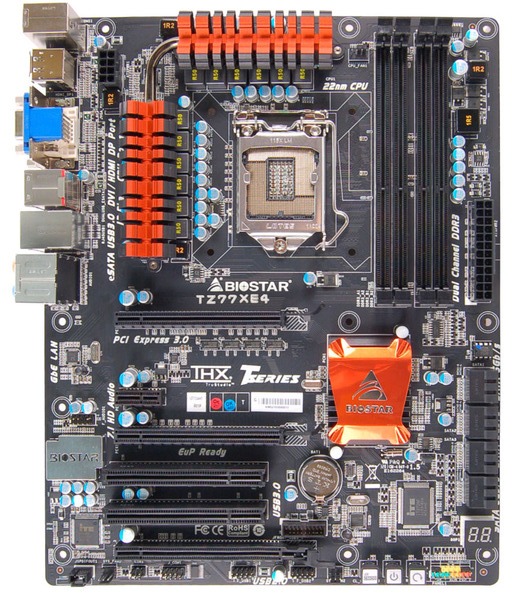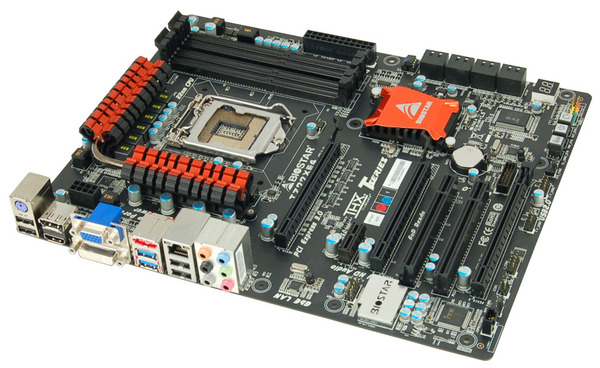Intel Z77 Panther Point Chipset and Motherboard Preview – ASRock, ASUS, Gigabyte, MSI, ECS and Biostar
by Ian Cutress on April 8, 2012 12:00 AM EST- Posted in
- Motherboards
- Intel
- Biostar
- MSI
- Gigabyte
- ASRock
- Asus
- Ivy Bridge
- ECS
- Z77
Biostar TZ77XE4—Visual Inspection
With memories of Biostar fresh in my mind from the 990FX roundup, I have another chance to tackle a motherboard from them. This one comes in at more of a premium than the other—at an MSRP of $169 it is not the cheapest board this time. However, it does seem to have learned some lessons with the PCIe layout at least, but in terms of features we are perhaps a bit lacking.
Biostar have characteristically been black and orange, and we see it here again on their top Z77 model, the TZ77XE4. Power delivery is essentially a 10+2 (CPU/iGPU) system with large brightly colored heatsinks to remove heat, both connected via a heatpipe. These heatsinks are set a little away from the Intel designated socket area, though the memory banks are right up against the boundary—with only two sticks of memory in the board there will be enough room for most of the beefiest air coolers.
In terms of fan headers, Biostar have unfortunately put much effort in here, with only three to play with—a 4-pin CPU fan header to the top right of the socket, and two 3-pin at the south end of the board. Anyone requiring headers for fans will have to resort to providing their own fan control.

Along the right hand side, apart from the 24-pin power connector, we have a series of eight SATA ports—two SATA 6 Gbps from the PCH, four SATA 3 Gbps also from the PCH, and another two SATA 6 Gbps from an ASMedia controller. These are unfortunately not color coded, meaning users will have to double check every time that the SATA cable is going into the port as intended. Below these, we have a two-digit debug display for error reporting.
The chipset heatsink sports the bright orange Biostar color, but is rather small which could lead to it being warm to the touch. On the south side of the board, we are not exactly bursting with headers—aside from the fans, we have front panel headers, a pair of USB 2.0 headers, and power/reset/clear CMOS buttons. These buttons are all similar and next to each other, so I can just see myself accidentally pressing the wrong one from time to time. It is also important to note the location of a USB 3.0 header, just above the third full-length PCIe slot. This is a rather awkward place, and cements its use primarily for rear facing adaptors (as long as there is nothing in the PCI slot beside it).

The PCIe layout is better than previous iterations, featuring an x16 (x8 in dual-GPU), x1, x8, PCI, PCI and Gen 2.0 x4. This leaves a space between GPUs, and a spare x1, PCI and x4 when dual GPUs are being used. Note we do not have a molex connector here, suggesting that Biostar are happy with the power delivery when the PCIe slots are in use.

For back panel functionality, we have a PS2 keyboard port, two USB 2.0 ports (black), DisplayPort, HDMI, D-Sub, DVI-I, eSATA, two USB 3.0 (blue), gigabit Ethernet, two more USB 2.0 (black), and audio jacks. I should stress that even though there is a DVI-I on the back panel, it does not accept analog signals by adaptor.
Board Features
| Biostar TZ77XE4 | |
| Size | ATX |
| CPU Interface | LGA-1155 |
| Chipset | Intel Z77 |
| Power Delivery | 10 + 2 + 1 + 2 (CPU/GPU/VCCIO/Memory) |
| Memory Slots |
Four DDR3 DIMM slots supporting up to 32 GB Up to Dual Channel, 1066-2600 MHz |
| Video Outputs | DisplayPort, HDMI, DVI-D, D-Sub |
| Onboard LAN | Realtek 8111E |
| Onboard Audio | Realtek ALC898 |
| Expansion Slots |
2 x PCIe x16 Gen3 (x16, x8/8) 1 x PCIe x16 Gen2 (x4) 1 x PCIe x1 Gen2 2 x PCI |
| Onboard SATA/RAID |
2 x SATA 6 Gbps (PCH), Support for RAID 0, 1, 5, 10 4 x SATA 3 Gbps (PCH), Support for RAID 0, 1, 5, 10 2 x SATA 6 Gbps (ASMedia Controller) 1 x eSATA 3 Gbps |
| USB |
4 USB 3.0 ports (2 back panel, 2 from headers) 8 USB 2.0 ports (4 back panel, 4 from headers) |
| Onboard |
4 x SATA 6 Gbps 4 x SATA 3 Gbps 1 x USB 3.0 Header 2 x USB 2.0 Header 3 x Fan Headers 1 x CIR Header 1 x SPDIF Output Header 1 x Front Panel Audio Header |
| Power Connectors |
1 x 24-pin ATX connector 1 x 8-pin 12V connector |
| Fan Headers |
1 x CPU Fan Header (4-pin) 2 x SYS Fan Header (3-pin) |
| IO Panel |
1 x PS/2 Keyboard Port 1 x eSATA 2 x USB 3.0 4 x USB 2.0 1 x DisplayPort 1 x HDMI 1 x DVI-D 1 x D-Sub 1 x Gigabit Ethernet Audio Jacks |
| Warranty Period | 3 years from date of sale |
| Product Page | Link |
Aside from the extra SATA controller, PCI slots, Power/Reset buttons and the use of all four display outputs, there's nothing much 'extra' that Biostar have put on the board which isn't already in the default chipset. This could perhaps be their downfall when it comes to conclusions after testing.










145 Comments
View All Comments
Zoomer - Tuesday, April 10, 2012 - link
So when is AMD buying them out and integrating this in their gfx cards / platform?neo55 - Sunday, April 8, 2012 - link
Will Z77 support two or three monitors simultaneously?GreenEnergy - Sunday, April 8, 2012 - link
You mean from the Ivy Bridge IGP?Well depends. (Its the same btw for H77, Z75 and Z77 etc.). You need to have 2 displayport if I remember correctly. So if you got for example DVI, HDMI and DP. Then 2 screens only. If you got DVI, DP, DP then 3. Or if you daisychain the DP?
dubyadubya - Sunday, April 8, 2012 - link
Listing fan header count and layout is useless if you do not test the functionality. Do they report RPM? Can they control fan speed? Does the fan control work with Speedfan etc. or only the software from the motherboard manufacturer? Several years ago many people including myself brought this to Anandtech's attention. At the time Anandtech stated they would include this missing info which they did. Trouble is the info was only included in one or two reviews before it was dropped. When I purchase a new motherboard I want to know this info. I have spent many hours searching for this info for each new build as most manufactures do not give detailed info even in the motherboard manual.IMO if a fan header exists it must have full functionality. If not the header should not be on the board. Motherboard manufactures need to pull their heads out of their asses. If Anandtech reported this info in reviews and gave negative reviews on boards with poor fan support the manufacturers would get the hint.
Nje - Sunday, April 8, 2012 - link
Yeah I would love to know this, particularly if the fan headers can control 3 pin fans as well (ie vary the voltage).ASUSTechMKT - Monday, April 9, 2012 - link
Primary CPU headers ( CPU and CPU OPT are fully controllable for 4 pin ) as the majority of CPU coolers are PWM for chassis headers ( 1-4 all allow for 3 pin and 4 pin fan control ).Zoomer - Tuesday, April 10, 2012 - link
Asus, can they be used with speedfan or is it BIOS/Asus software only?ASUSTechMKT - Monday, April 9, 2012 - link
This has been noted in the last couple of reviews. Specifically for ASUS we have spent considerable time putting quality fan controls on our boards all headers allow for 3 presets as well as min and max rotation and target temperatures. In addition with our software for this generation we offer full calibration per each header that can sense the min and max rotation and provide this information as well as sync this data to the profiles. Overall it is quite extensive make sure to check out our videos coming up which shows it in great depth.Arbie - Monday, April 9, 2012 - link
@dubyadubya - Look on the bright side: at least one manufacturer (Asus) takes fans seriously, and at least one reviewer (Anandtech) is even mentionng the fact.I have the same wants as you do, and have made the same requests, but be reasonable. These aren't full motherboard reviews! They don't even have the boards operable, much less any hands-on time with BIOS details.
And when they do have all that, a higher priority will be PCIe lanes and how many graphics cards can be stuffed in. That's because you can't run any modern games with only one board.
But then they might talk a little more about the fan controls... Let's hope. Again - be glad that even one vendor is paying attention and has included some controls to be talked about.
Cavalcade - Sunday, April 8, 2012 - link
With a slightly more than passing knowledge of rendering, and having spent a fair amount of time handling input in a game engine, I'm curious as to how Lucid came to the responsiveness numbers in the chart on page 3. The concept seems valid at first glance, but the numbers strike me as pure marketing fodder as opposed to solid and testable results.Also, this sort of technology seems far better suited to residing in the driver layer as opposed to yet another piece of middleware for PC gamers to contend with. We're already effectively blocked from the hardware, and forced to go through third-party graphics APIs (Direct3D/OpenGL).
Maybe it's a "you have to see it (feel it)" kind of thing, but from here you can color me skeptical.